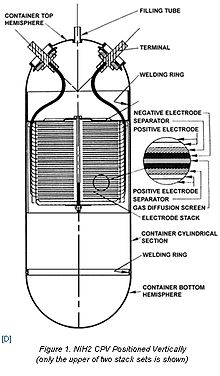- Nickel–hydrogen battery
-
A nickel–hydrogen battery (NiH2 or Ni–H2) is a rechargeable electrochemical power source based on nickel and hydrogen.[1] It differs from a nickel–metal hydride (NIMH) battery by the use of hydrogen in a pressurized cell at up to 1200 psi (82.7 bar) pressure.[2]
The cathode is made up of a dry sintered[3] porous nickel plaque, which contains nickel hydroxide, the negative hydrogen electrode utilises a teflon-bonded platinum black catalyst, the separator is knit zirconia cloth [4][5]
NiH2 cells using 26% potassium hydroxide (KOH) as an electrolyte have shown a service life of 15 years or more at 80% depth of discharge (DOD)[6] The energy density is 75 Wh/kg, 60 Wh/dm3[7] specific power 220 W/kg.[8] The open-circuit voltage is 1.55 V, discharge voltage 1.25 V,[9] and the voltage under load 1.5 V.
While the energy density is only around one third as that of a lithium battery, the specific property of the nickel–hydrogen battery is its long life: the cells handle more than 20,000 charge cycles[10] on 85% efficiency.
NiH2 rechargeable batteries possess good electrical properties which make them attractive for the energy storage of electrical energy in satellites[11] and space probes. For example, the ISS,[12] Mars Odyssey[13] and the Mars Global Surveyor[14] are equipped with nickel–hydrogen batteries. The Hubble Space Telescope, when its original batteries were changed in May 2009 more than 19 years after launch, led with the highest number of charge and discharge cycles of any NiH2 battery in low earth orbit.[15]
Contents
History
The development of the nickel hydrogen battery started in 1970 at Comsat[16] and was used for the first time in 1977 aboard the U.S. Navy's Navigation technology satellite-2 (NTS-2).[17]
Designs
Individual pressure vessel
The individual pressure vessel (IPV) design consists of a single unit of NiH2 cells in a pressure vessel. [18]
Common pressure vessel
The common pressure vessel (CPV) design consist of two NiH2 cell stacks in series in a common pressure vessel. The CPV provides a slightly higher specific energy than the IPV.
Single pressure vessel
The single pressure vessel (SPV) design combines up to 22 cells in series in a single pressure vessel.
Bipolar
The bipolar design is based on thick electrodes, positive-to-negative back-to-back stacked in a SPV. [19]
Dependent pressure vessel
The dependent pressure vessel (DPV) cell design offers higher specific energy and reduced cost.[20]
Common/dependent pressure vessel
The common/dependent pressure vessel (C/DPV) is a hybrid of the common pressure vessel (CPV) and the dependent pressure vessel (DPV) with a high volumetric efficiency.[21]
- Schematics
See also
References
- ^ A simplified physics-based model for nickel hydrogen battery
- ^ Nickel-hydrogen spacecraft battery handling and storage practice
- ^ Performance comparison between NiH2 dry sinter and slurry electrode cells
- ^ [1].
- ^ Nickel-Hydrogen Batteries
- ^ Potassium hydroxide electrolyte for long-term mickel-hydrogen geosynchronous missions
- ^ Spacecraft Power Systems Pag.9
- ^ NASA/CR—2001-210563/PART2 -Pag.10
- ^ Optimization of spacecraft electrical power subsystems -Pag.40
- ^ Five-year update: nickel hydrogen industry survey
- ^ Ni-H2 Cell Characterization for INTELSAT Programs
- ^ Validation of International Space Station electrical performance model viaon-orbit telemetry
- ^ A lightweight high reliability single battery power system for interplanetary spacecraft
- ^ Mars Global Surveyor
- ^ NiH2 reliability impact upon Hubble Space Telescope battery replacement
- ^ Nickel-hydrogen battery technology—development and status
- ^ NTS-2 Nickel-Hydrogen Battery Performance 31
- ^ Nickel hydrogen batteries-an overview
- ^ Development of a large scale bipolar NiH2 battery.
- ^ 1995–dependent pressure vessel (DPV)
- ^ Common/dependent-pressure-vessel nickel-hydrogen Batteries
External links
- Overview of the design, development, and application of nickel-hydrogen batteries
- Details of the NiH2-battery
- Implantable nickel hydrogen batteries for bio-power applications
- NASA handbook for nickel-hydrogen batteries
- A nickel/hydrogen battery for terrestrial PV systems
- A microfabricated nickel-hydrogen battery using thick film printing techniques
External reading
- Albert H. Zimmerman (ed), Nickel-Hydrogen Batteries Principles and Practice, The Aerospace Press, El Segundo, California
Categories:- Rechargeable batteries
- Hydrogen technologies
Wikimedia Foundation. 2010.







